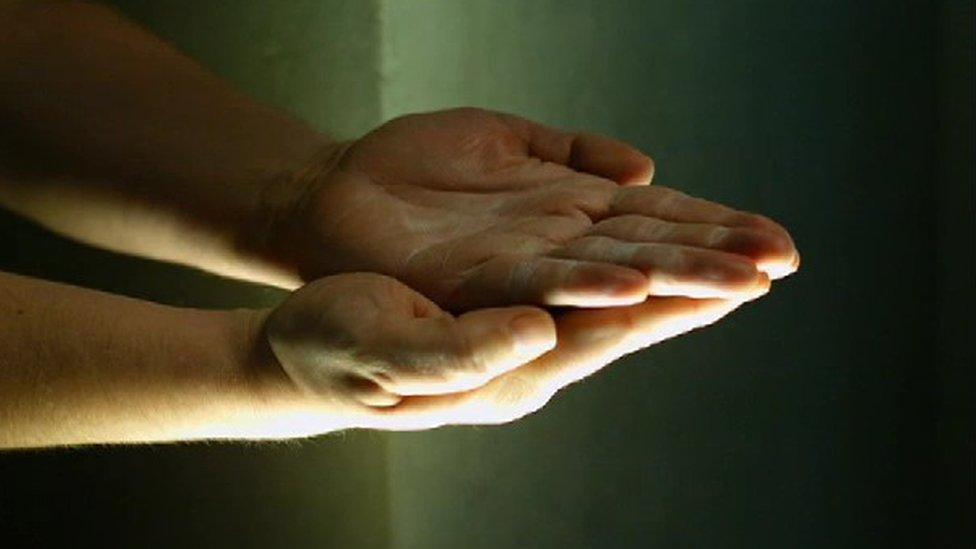How the tawse left its mark on Scottish pupils
- Published
The Tawse was the Scottish education system’s corporal punishment weapon of choice
For children schooled in Scotland right up until the 1980s, a particular leather product was the source of fear and dread - the Lochgelly Tawse.
The tawse, a Scots word meaning thongs of a whip, was an essential part of the teacher's trade.
It was the Scottish school's corporal punishment weapon of choice against unruly students and enforced a strict atmosphere in classrooms from Shetland to the Borders.
While students throughout the rest of the UK were punished by use of belt or cane, Scottish teachers used this modified version of the belt - a thick leather whip with one end split in to two tails, or tawse.

The strap was frequently used in Scottish classrooms until the 1980s
"The culture of the society completely accepted this. The parents were all for it," historian Sir Tom Devine tells the BBC Scotland documentary Growing up in Scotland: A century of childhood.
According to educational policy expert Prof Lindsay Paterson: "The threat of physical violence was present in schools but then it was present in families, it was present in communities, it was present through the church.
"The schools simply saw themselves as reproducing that - ethics were to be instilled partly by the threat of violence."
Students were not only disciplined for disobeying rules or disorderly behaviour but simply for not understanding a lesson, or for answering a question incorrectly.

The Lochgelly Tawse was the most popular design
Prof Devine, from Edinburgh University, says: "There is plenty of evidence that if you failed to gain a certain mark then the belt would be produced."
The Reverend Bill Brown tells the Growing up in Scotland programme he got belted one day for spelling Canada with a small 'c'.
He says: "It led to a mini breakdown. It was almost like a mental breakdown.
"The consequence of which was that I became withdrawn. I missed a couple of years of school."
He adds: "I think it is appalling to think we would hit children with a belt like this.
"It is incredible to think there was actually a production line producing these so that teachers would always have one."
Throughout the mid-20th century, Scotland's saddlers and leather makers developed their techniques in creating a tawse that was fast to manufacturer, easy to wield, yet firm when used.

The tawse was designed to hurt the hands but not draw blood
However one manufacturer's design rose above the rest, and is said to have held the majority of the tawse market, estimated at 70%.
Based in Lochgelly, Fife, John J Dick Leather Goods were the teacher's preferred suppliers at the height of the tawse's reign of terror.
The Lochgelly Tawse was made by cutting 2ft long strips of leather from pre-tanned and pre-curried hides.
The leather would then be dressed and cut halfway up the middle to form the tails.
The particular design of the tails provided the searing nip when it struck the student's hand.
However, the Lochgelly method was preferable in that the tails were "edged" in order to prevent drawing blood.

In the early 1970s demand for the tawse was strong but a modern manufacturing method was required to keep up with orders from teachers not just in Scotland, but across the UK.
The company modernised their method with a state-of-the-art three-phase cutting press, allowing manufacturing of the tawse on a factory scale.
By the end of the 1970s it became harder to source leather thick enough to manufacture the heavier versions of the tawse and public opinion on corporal punishment was slowly starting to change.
By 1983 the use of corporal punishment was beginning to be phased out in state schools after two Scottish mothers won an action in the European Court of Human Rights.
Use of the Lochgelly Tawse and any other form of corporal Punishment was finally banned in state schools in 1987, with Scottish private schools following suit over 10 years later in 1998.
Margaret Dick is granddaughter of George Dick and daughter of John Dick, the men behind the infamous Lochgelly design.
She still runs the family leather goods business from Lochgelly, supplying leather wares for Sgain Dubhs, harnesses and handbags.
Surprisingly the manufacturing of the tawse continues, though only as a collector's item, and not on the scale of years gone by.
Margaret has mixed feelings about the tawse and finds it surprising that so many people are still interested in it.
She says: "It's just part of the history of my family, and like it or lump it, I'm stuck with that."